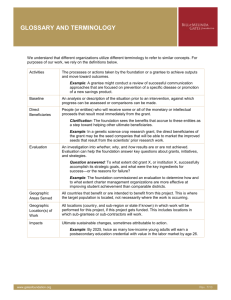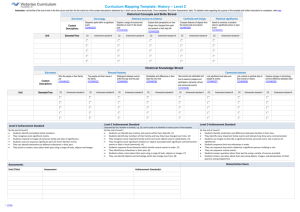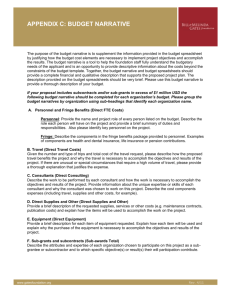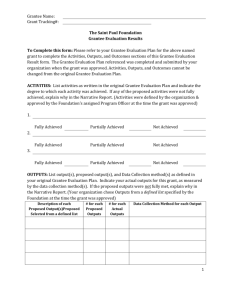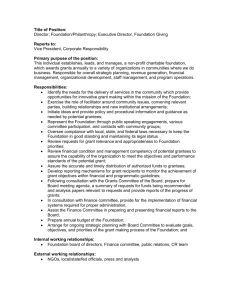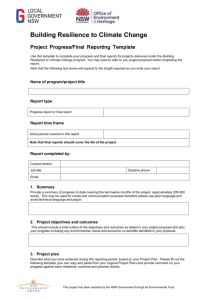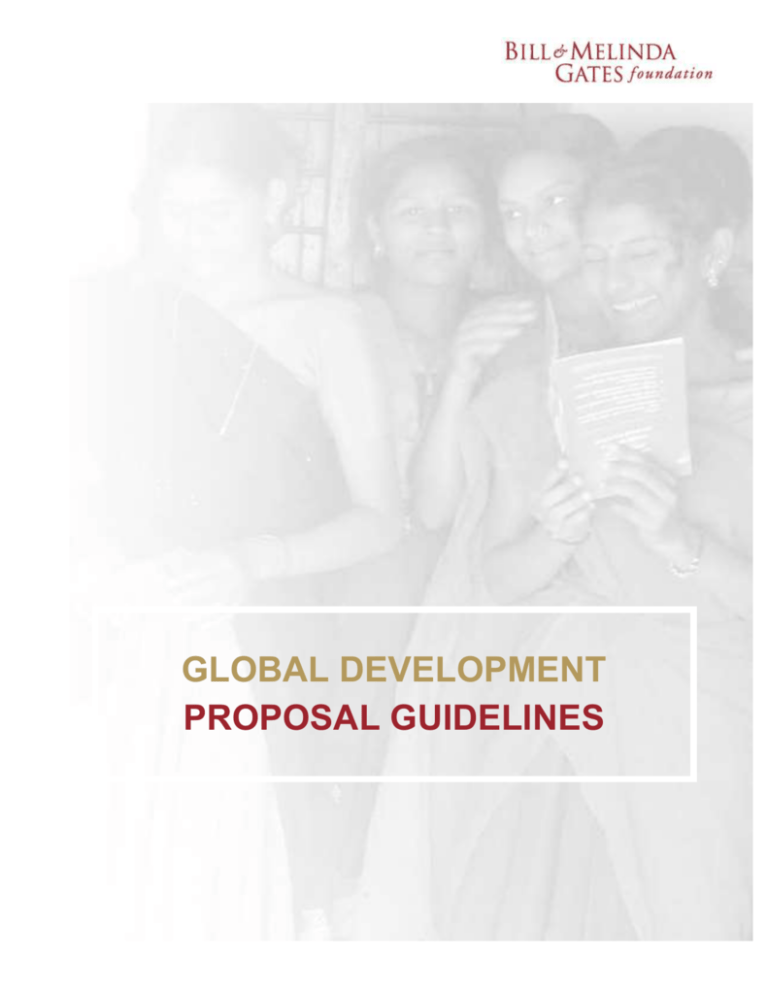
GLOBAL DEVELOPMENT
PROPOSAL GUIDELINES
GLOBAL DEVELOPMENT PROPOSAL GUIDELINES
Preface
The Bill & Melinda Gates Foundation believes that all lives have equal value and every person should
have the opportunity to live a healthy, productive life. The Global Development Program was established
with the goal of increasing opportunity by reducing poverty and hunger and by expanding access to
information in the developing world. In that context, the Global Development Program has focused its
grantmaking on proposals with the potential for high impact and sustainable solutions that collectively can
reach millions of people within specifically identified program strategies and geographies.
We appreciate your organization’s interest in submitting a proposal to the foundation. We suggest that
you read through this entire document before beginning your proposal. In addition, for more information
about the foundation’s grantmaking priorities and processes please refer to the following links:
Foundation Grantmaking Priorities
Our Approach to Grants
Thank you for working with us throughout the proposal process. A designated foundation program officer
will work closely with your organization during preparation of your proposal to help you understand the
connection between the foundation's relevant program strategy and the proposed project, as well as to
respond to any questions you might have over the course of this process. You are encouraged to
communicate with the program officer to make sure that your efforts are aligned with the proposal
requirements and that you are not expending unnecessary time or energy in this process.
Proposal Assessment
The Global Development Program reviews the funding opportunities under consideration for alignment
with established program strategies, and evaluates them for their potential to contribute to impact and
achieve identifiable and sustainable results. We consider the following information when evaluating a
proposal.
Project Description and Alignment with Foundation Strategy
First and foremost, we review the description of the project, the need that the project seeks to address,
and how addressing that need contributes to a designated strategy within Global Development’s specific
areas of focus: Agricultural Development; Financial Services for the Poor; Global Libraries; Special
Initiatives (including Urban Poverty, and Emergency Response); Water, Sanitation, and Hygiene; and
Policy and Advocacy. Before you draft your proposal, we encourage you to seek clarity from your
designated program officer about the Global Development Program strategy that is relevant to your
project.
Sustainability and Scalability
We evaluate whether the project can be scaled and replicated if appropriate, and whether it will create
solutions that can be continued after our funding has ended.
Intended Results
The project must have specific and clearly articulated results, as well as identified key milestones that
enable us to assess progress throughout the life of the project. The Results Framework referred to later in
these proposal guidelines will enable you to identify key results and milestones that demonstrate progress
throughout the project.
Rev. 5/12
GLOBAL DEVELOPMENT PROPOSAL GUIDELINES
Organizational Capacity
Both the organization (or department, if applicable) and its leadership must be able to successfully
implement the project. We ask that you provide sufficient information to show how the focus and
capabilities of your organization will support the proposed work and how the capacity, experience, and
expertise of the organization’s leadership are adequate to manage the project successfully.
Budget
We examine the efficiency and reasonableness of the budget, in the context of the proposed results of
the project for which you are requesting funding. You will be provided with a budget template as well as
narrative questions regarding your budget to facilitate your preparation and our review.
Proposal Review
During the course of the proposal development, foundation staff works with you to ensure that your
project aligns with the strategic priorities of the Global Development Program. Both internal and external
experts conduct programmatic reviews and compliance reviews to ensure that legal, financial, and
administrative requirements are met. Program staff submit final proposal documents to appropriate
executive team members along with their analysis and recommendation for final review and approval or
denial. You may receive requests for additional information throughout this process. Actual funding
occurs only after the foundation has approved a grant, and your organization and the foundation sign a
grant agreement.
Formatting
All project proposals submitted to Global Development, except for conference support and emergency
relief proposals, must use the application form contained in these guidelines. We ask that proposals be
concise and in proportion to the complexity of the project. Please try to contain the proposal narrative,
covering sections I - IX of these guidelines, to no more than 20 pages single spaced (with one-inch
margins and no smaller than 10-point font) excluding the proposal information page, table of contents,
Results Framework, appendices, and templates (plus additional information modules if requested). When
you respond to the questions, you may use paragraphs or bullet points—whatever works best for the
proposed project.
Please use U.S. letter page formatting (8.5x11.0 inches), and include your organization’s name in the
footer. Due to tax, legal, and reporting requirements, all grant proposals must be submitted in English.
Under limited circumstances, you may include Internet links to selected information; however, we ask that
you not assume that reviewers will visit the sites. For this reason, please include all critically necessary
information in the body of the proposal itself.
Our Commitment to Grantees: Strengthening Partnerships
Our grantees and partners are at the core of our mission and work. We are most effective when we are
working together with partners to achieve the shared impact we all desire.
Achieving results depends on many factors, including the quality of our partnerships. We can achieve
greater impact by forging stronger relationships with our most important partners—our grantees.
Our Commitment to Grantees
1. Quality interactions—You will be treated with respect and candor.
2. Clear and consistent communications—You will know when and who will make the decision
on your grant, and you will be provided clear communications on the foundation’s strategy, grant
www.gatesfoundation.org
3 of 16
GLOBAL DEVELOPMENT PROPOSAL GUIDELINES
process and the amount of time and assistance you could expect to receive from the foundation
once your grant is awarded.
3. Feedback—You will have opportunities to provide feedback – and we will use that feedback to
make continuous improvements.
We welcome your feedback. It is a critical part of our commitment because your ideas, assessment and
comments will help to ensure greater success in our mutual goal to improve lives. We receive feedback
daily through interactions between our program staff and grantees. We seek feedback through periodic
interviews and focus groups. And every two to three years, we ask the Center for Effective Philanthropy
to conduct a grantee perception survey.
We also make available to grantees several other online means of providing feedback:
Send an email to our grantee partner engagement team at granteesurvey@gatesfoundation.org.
Share your viewpoint on Twitter via #gateschat.
If your feedback regards a specific allegation, and you want the information to be kept confidential
from foundation staff, we encourage you to report this information to EthicsPoint . This is a
service provided by a third party outside of the foundation that is available for reporting and
identification of issues, events and behavior that may be inconsistent with our foundation’s
values.
Glossary and Terminology
We understand that different organizations utilize different terminology to refer to similar concepts. For
purposes of this proposal and future communications regarding this project, please rely on the definitions
below.
Activities
The processes or actions taken by the foundation or a grantee to achieve outputs
and move toward outcomes.
Example: A grantee might conduct a review of successful communication
approaches that are focused on prevention of a specific disease or promotion
of a new savings product.
Baseline
An analysis or description of the situation prior to an intervention, against which
progress can be assessed or comparisons can be made.
Direct
Beneficiaries
People (or entities) who will receive some or all of the monetary or intellectual
proceeds that result most immediately from the grant.
Clarification: The foundation sees the benefits that accrue to these entities as
a step toward helping other ultimate beneficiaries.
Example: In a genetic science crop research grant, the direct beneficiaries of
the grant may be the seed companies that will be able to market the improved
seeds that result from the scientists’ prior research work.
Evaluation
An investigation into whether, why, and how results are or are not achieved.
Evaluation can help the foundation answer key questions about grants, initiatives,
and strategies.
Question answered: To what extent did grant X, or institution X, successfully
accomplish its strategic goals, and what were the key ingredients for success—
or the reasons for failure?
Example: The foundation commissioned an evaluation to determine how and
www.gatesfoundation.org
4 of 16
GLOBAL DEVELOPMENT PROPOSAL GUIDELINES
to what extent charter management organizations are more effective at
improving student achievement than comparable districts.
Geographic
Areas Served
All countries that benefit or are intended to benefit from this project. This is where
the target population is located, not necessarily where the work is occurring.
Geographic
Location(s) of
Work
All locations (country, and sub-region or state if known) in which work will be
performed for this project, if this project gets funded. This includes locations in
which sub-grantees or sub-contractors will work.
Impacts
Ultimate sustainable changes, sometimes attributable to action.
Example: By 2025, twice as many low-income young adults will earn a
postsecondary education credential with value in the labor market by age 26.
Indicators
Quantitative or qualitative variables that specify results for a particular strategy,
initiative, or grant.
Similar terms: Metrics, measures
Clarification: Indicators form the basis of monitoring and evaluation because
they tell us how to assess different outputs, outcomes, and impacts.
Example: An agriculture grantee might measure the percentage increase in an
average crop yield as an indicator of the effectiveness of the improved seeds
that it helped develop.
Inputs
The resources used to implement activities.
Clarification: Inputs typically include financial, human, and material/equipment
resources, as well as the efforts of foundation staff, partners, and grantees.
Example: Inputs may include items such as building materials, technical
assistance, staff, and vehicles.
Key Milestones
A subset of all milestones that may exist in a project workplan, these are the most
critical project activities, outputs, and outcomes that are included in the grant
agreement. Grantees regularly report on their progress toward achieving the key
milestones; these reports are expected for future funding.
Measurement
The process of collecting and recording observations during an inquiry.
Clarification: At the foundation, measurement activities include indicator
monitoring, evaluation, and long-term impact tracking. We also use the term
“measurement” to refer to a set of principles and practices associated with
these activities.
Milestones
Sequential signs of progress during a project or initiative, usually tied to estimated
completion dates.
Example: One milestone for a grantee might be to mobilize a certain amount of
additional investment from other partners by the end of 2011 to support the
grantee's work.
Monitoring
A process of collecting, analyzing, and using data to ensure compliance and
improve performance, comprised of both qualitative and quantitative data collection
methods. Monitoring tells us whether milestones and basic targets are being met,
and whether critical activities are proceeding as planned.
Similar term: Performance measurement
Objectives
www.gatesfoundation.org
The major components of the project required to achieve results.
5 of 16
GLOBAL DEVELOPMENT PROPOSAL GUIDELINES
Clarification: An objective could be any subdivision of work that makes sense
as a logical way to organize the project's key activities, outputs, and
outcomes—such as a geographic location or a body of work.
Example: One such body of work might be: “Conduct a needs or readiness
assessment.” This objective would have a set of associated results (mainly
activities and outputs), including conducting site visits, interviewing experts,
analyzing data (activities), and writing a report (an output).
Outcomes
Intermediate observable and measureable changes that may serve as steps toward
impact for a population community, country, or other category of beneficiary.
Examples: Possible outcomes may include a reduction in the number of new
disease cases, an increase in crop yield, and statewide adoption of new best
practices in education.
Outputs
The direct and early results of a grant or intervention’s activities. Outputs refer to
the most immediate sets of accomplishments necessary, but not sufficient, to
produce outcomes and impacts.
Examples: Possible outputs may include the number of people trained, the
number of public service announcement radio spots on the topic of proper
contraceptive use, and the number of tons of new seed varieties distributed.
Results
Any of the foundation or grantees’ inputs, activities, outputs, outcomes, and
impacts.
Clarification: “Results” is used as a generic, all-encompassing term that can
include all positive or negative changes, as well as the absence of any change
at all. When possible, it is best to use more specific terms, such as impacts,
outcomes, outputs, activities, and inputs. The results of almost all grants will
likely include outputs; some will include outcomes; and few, if any, will in and of
themselves include impacts.
Example: Possible results may include technical assistance (input), a review of
communications approaches (activity), the number of people trained (output);
an increase in crop yield (outcome), and by 2025 a doubling in the number of
low-income young adults who will earn a postsecondary education credential
with value in the labor market by age 26 (impact).
Scalability
The degree to which a piloted intervention can function, adapt to increased
demands, and deliver similar/expected results when applied to a significantly larger
context (e.g., with expanded sets of beneficiaries, regions, geographies, policies,
and political circumstances).
Sustainability
The degree to which achieved results, particularly outcomes and impacts, can
continue over time, especially after foundation funding ends.
Targets
Specific values or projections for intended results, to be achieved within particular
timeframes.
Clarification: Note that it is not necessary to set targets for all intended
results.
Example: If the indicator is “# of children vaccinated,” then a target might be
“10,000 children vaccinated by June 2012.” So a result (in this case, probably
an outcome) might be “5,000 children vaccinated” or “100,000 children
vaccinated”—depending on what was achieved by June 2012.
Ultimate
www.gatesfoundation.org
People (or entities) whose lives or experiences we expect to change as an eventual
result of the grant.
6 of 16
GLOBAL DEVELOPMENT PROPOSAL GUIDELINES
Beneficiaries
Clarification: Grant proposals should be able to trace a conceptual link to their
intended ultimate beneficiaries, even if the proposed project itself will not work
directly with these people (or entities).
Example: In a genetic science crop research grant, the ultimate beneficiaries
of the grant may be the farmers who will be able to buy and plant the improved
seeds that result from scientists’ prior research and seed companies’ sales and
distribution efforts.
Restrictions on Lobbying Activities
The foundation is prohibited from conducting or funding any lobbying or political campaign activities, as
these terms are specifically defined under U.S. tax law. Unlike many of our grantees who may engage in
limited lobbying, the foundation cannot lobby or fund any lobbying activities carried out by its grantees.
We request that you please review the information at the following link, Foundation Funds and Advocacy,
to assess whether any of your proposed activities may constitute lobbying as defined by the IRS. If so,
you should revise your proposal accordingly prior to submission.
Privacy Notice
This document is subject to the Gatesfoundation.org Privacy Policy and Terms of Use.
www.gatesfoundation.org
7 of 16
GLOBAL DEVELOPMENT PROPOSAL GUIDELINES
Grant Proposal
Date
Please update the date each time you submit a revised version.
Project Title
Organization
Name
Institutional official authorized to submit and accept grants on behalf of the organization:
Prefix
First Name
Surname
Suffix
Title
Address
Telephone
Fax
Email
Web Site
Project Director/Primary Contact:
Prefix
First Name
Surname
Suffix
Title
Address
Telephone
Fax
Email
Web Site
U.S. Tax Status (Refer to Tax Status Definitions)
Geographic Location(s) of Project
Amount Requested
from Foundation in
Dollars (U.S.)
$
Project
Duration
(months)
Organization’s
Fiscal Year-End
Date
Estimated Total
Cost of Project in
Dollars (U.S.)
Organization’s Total
Revenue for Most
Recent Audited
Financial Year in
Dollars (U.S.)
www.gatesfoundation.org
8 of 16
GLOBAL DEVELOPMENT PROPOSAL GUIDELINES
I.
Charitable Purpose
In one sentence, please describe how this project will help the foundation meet its charitable objectives.
For example: “To develop improved drought-resistant crop varieties to protect resource-poor farmers” or
“To dramatically increase the number of active savings accounts serving low-income families in Latin
America.”
II.
Executive Summary
Please include up to a one-page summary of the proposal. This overview is intended to be a high-level
summary of the proposal to be used for reference within the foundation, not a substitute for the more
specific information requested in other sections of the proposal.
III. Project Description
Please describe:
the project itself and what it will do
the specific need being addressed by this project
why this project is an effective means through which to address this need
the direct and ultimate beneficiaries of the project (identifying gender, where relevant)
the geographic areas served
what foundation funding for this project will enable your organization to accomplish that it would not
be able to accomplish otherwise
to the extent known, the key partner organizations, sub-contractors, and sub-grantees that are
critical to the project’s successful implementation, including the history and current status of these
relationships
if applicable, how this project relates to or builds upon previous or ongoing funding you have
received from the foundation
IV. Alignment with Foundation Strategy
Please describe the relevant foundation strategy or strategies with which this project will align, and
how they will align. When you formulate your response, please refer to any relevant program
strategy information that is publicly available, as well as specific discussions you have had with
your foundation program officer.
Please discuss the existing relevant research and efforts in this field, with focus on how the
proposed project fits in this broader context.
V. Sustainability and Scalability
How do issues related to equity, self-reliance, sustainability (economic, environmental, social, etc.),
and scalability affect the need you are addressing, and how will your project take these into
consideration?
Does your organization intend to increase the scale of this project after the grant period has ended?
If so, how will the project scale be increased, what is in place now to support scalability, and what
actions will your organization and project partners take during the project term to facilitate scalability
after the grant period has ended?
Does your organization intend to have this project continue after the grant period has ended? If so,
what actions will your organization and project partners take during the grant period to facilitate
sustainability, and how will the project be sustained when the grant period has ended?
www.gatesfoundation.org
9 of 16
GLOBAL DEVELOPMENT PROPOSAL GUIDELINES
Please note relevant assumptions and risks associated with sustainability and scale, and state how
you plan to account for and/or mitigate them.
VI. Implementation, Intended Results, and Results Measurement
A.
Results Framework
Please complete the Results Framework to summarize the project’s intended activities,
outputs, outcomes, and key milestones. In completing the Results Framework, please refer to
the glossary that is included in these guidelines for clarification of terms. Note: If this project
is funded, the Results Framework will become part of your grant agreement with the
foundation; the platform for ongoing discussion, planning, and negotiation between you and
your designated program officer; and the basis for your reporting on project status throughout
the term of the grant.
B.
Project Plan
Please provide us with a brief narrative describing:
how an understanding of the ultimate beneficiaries of the project influenced the project
design
the overall approach you will use to accomplish the intended results, including the project
design and major activities, making clear your role and the roles of key partners
the vision of success for, and the most important result of, this project
C.
Analysis
Please describe why you are confident that:
the pace of activities is reasonable, the project will be implemented, and the intended
results will be achieved within the identified timeframes
successful completion of the activities will lead to the identified outputs and, where
applicable, outcomes
the key milestones are reasonable measurement tools for marking progress
the project design leaves room for innovation, adaptation, and unanticipated outcomes
that may arise based on experience and learning
D.
Assumptions and Risks Concerning Implementation and Results
Please discuss any significant assumptions and risks to successful achievement of the stated
results, any steps you have taken or will take to mitigate those risks, and, to the extent the
risks still exist, why you are confident that you can achieve the intended results regardless of
the risks.
E.
Measurement
www.gatesfoundation.org
How will your organization track, measure, and monitor progress toward meeting the
grant activities, outputs, outcomes, and key milestones during and at the end of the grant
period?
What is your organization’s plan for assessing, documenting, and using lessons learned
about the project?
10 of 16
GLOBAL DEVELOPMENT PROPOSAL GUIDELINES
VII. Organizational Capacity
A.
Applicant
B.
Please describe your organization’s strengths and its capacity to implement, manage,
and monitor progress of this grant. In responding to this question, please include the
following information in your answer:
o your organization’s mission, goals, and current activities related to the proposed
project
o how this project furthers the specific mission and goals of your organization
o a description of your organization’s leadership, management, project team, and
operational structure
o any similar types of projects that your organization has undertaken in the past,
including the identified results of the projects and the projects’ successes in achieving
those results
o any unique strengths or activities of your organization that make it particularly well
suited to implementing this project
Please describe any steps that your organization would need to take to increase its
capacity in order to successfully implement this project, the plan for doing so, and the
organization’s plan for maintaining that capacity if necessary for sustainability of the
project after foundation funding for this project is complete.
Please describe any prior grants that your organization has received from our foundation
that are relevant to this proposal, and the results of those grants.
Please describe specifically how your organization will administer and manage funds for
this project, either directly or through a third party.
Partners and Sub-Grantees
Please describe:
why you have chosen any key partner organizations, sub-contractors, and sub-grantees,
and what has made you comfortable with their capacity for successful implementation of
this grant
the history and current status of these relationships
C.
Organizational Assumptions and Risks
Please discuss any significant organizational assumptions and risks to successful
implementation of this project, what steps you have taken or will take to mitigate those risks,
and to the extent that the risks still exist, why you are confident about proceeding regardless
of the risks.
VIII. Budget Template and Narrative
The budget component of the grant proposal consists of a budget template and the corresponding budget
narrative. Together, the template and narrative provide a clear picture of the financial resources you are
requesting to support the project. The template focuses on articulating what the costs are to implement
the project successfully, and the narrative should focus on why those costs are reasonable and
appropriate for the project.
The Budget Template is contained in a separate Excel file to submit with your proposal. Instructions for
completing the budget template are included in the template. Please include total project costs in both the
template and narrative, regardless of funding source. The template will automatically create a separate
Bill & Melinda Gates Foundation-only budget based on the data that you provide.
The budget narrative questions are listed below; please answer them in the body of the proposal itself.
We have divided the narrative questions into general questions and questions targeted to specific budget
www.gatesfoundation.org
11 of 16
GLOBAL DEVELOPMENT PROPOSAL GUIDELINES
components. Responses to both sets of questions give us a clear understanding of the financial
resources you are requesting to support the project, as well as your level of confidence that the resources
being requested will support the results you have identified.
General Questions
What are the general methodologies you used to develop your cost estimates?
How is this proposed budget realistic and reasonable in relation to the specific grant results you
have identified?
What efforts will you take to ensure that you deploy funds in an optimal manner?
What are the prospects for cash or in-kind financial support from other sources that directly
support project activities?
What are the significant financial risks and other factors that could materially affect your
organization’s ability to operate within the proposed budget? How will your organization
manage or mitigate those risks and factors? Please be sure to address potential consequences
of delayed spending.
Specific Questions
A. Personnel
With regard to full-time equivalent (FTE) employees (meaning a single person or combination of
people who work the equivalent of one full-time person) or group of FTEs that will be working
on the project, please describe:
the roles and responsibilities of each FTE or group of FTEs on the project
the rationale for the number of requested FTEs in that role
the methodology for estimating the base salary for that role (for example, describe whether
you are using the actual salary of current employees or an estimate based on current
employees with similar job descriptions; you do not need to include the actual salary
numbers in the narrative) and any key assumptions that will influence that salary (for
example, the person will be a local hire in the developing world versus someone who is
not)
the set of benefits and calculations used to determine the percentage of salary included for
benefits for each FTE or group of FTEs, including all non-wage compensation
the assumptions used for any annual salary increases
Note: Due to federal tax law, the foundation cannot support salaries for U.S. government
officials. If any U.S. government officials will be part of the project, please clarify that they will
be supported by other sources of funding.
B. Travel
Please describe:
the methodology used to calculate the total cost estimates for each trip
the assumptions used to determine the appropriate number of trips
the rationale for how those trips will support achievement of the results of the project
C. Sub-Grants to Other Organizations
To the extent that these points have not been discussed in the proposal already, please
describe:
the work to be conducted by the sub-grants and indicate the names of sub-grantees (if
known)
your previous experience working with any known sub-grantees
the assumptions used to estimate the cost of each line item (for example, a sub-grant
budget has been submitted to you or you have estimated an award size based on your
experience with similar work)
www.gatesfoundation.org
12 of 16
GLOBAL DEVELOPMENT PROPOSAL GUIDELINES
Please describe your process for conducting due diligence on potential sub-grantees from a
financial perspective. If any particular sub-grantee represents a significant component of the
project, please work with your designated program officer to determine whether the subgrantee should submit a separate budget.
D. Capital Equipment
Please provide information about the project’s capital equipment expenditures, including:
the equipment to be purchased
the business purpose of the equipment as it relates to the project
the cost and depreciation assumptions used
Notes:
Capital equipment includes any item purchased for the project with a unit cost greater than
$5,000 (U.S.) per item and a useful life greater than one year, regardless of whether you
intend to capitalize the expense under your own accounting policy or not. This could
include vehicles, laboratory equipment, or certain software packages.
Items that cannot be considered dedicated project equipment (e.g., vehicles used for some
fraction of the time) should be justified in relation to the proposed activity.
For equipment to be shipped to developing countries, applicants should request waiver of
import fees where possible.
As needed, funds should be requested to operate, insure, and maintain critical pieces of
equipment as part of the Other Direct Costs of the project.
Use of any equipment (whether capital equipment or not) that is purchased with grant funds
is limited to charitable purposes for the depreciable life of the equipment. This includes
computers, printers, faxes, telephones, vehicles, and all other equipment that is to be
purchased for use in the project.
For many non-U.S. entities, U.S. tax law considerations may affect whether the foundation
will permit purchase of equipment with a depreciable life that is greater than the grant
period being requested. In such cases, leasing is preferable. Please be certain to discuss
this with your program officer when you are developing a budget plan.
E. Consultants
With regard to your anticipated use of consultants or set of consulting contracts, please
describe:
the work to be performed in support of the overall project
the current status of the contract (whether the contract is confirmed or projected)
the cost assumptions used (including estimates of the number of days to be worked and
the daily rate)
the general terms of the contract, such as whether the payment(s) is based on an agreed
total amount, or an agreed per diem rate including travel and other related expenses
Note: This category also includes any fees to be paid to outside attorneys, accountants, or
auditors who are directly and exclusively related to the project.
F. Other Direct Costs
For other direct costs, please describe:
the item being requested
the business purpose of the item as it relates to the project
the cost assumptions used to generate the cost estimate
Note: Facility-related costs are typically covered by indirect costs and are not included within
the direct cost detail. However, in rare cases, facility-related expenses can be included as a
www.gatesfoundation.org
13 of 16
GLOBAL DEVELOPMENT PROPOSAL GUIDELINES
direct cost when a grantee requires additional building expenses in order to execute the grant
(for example starting up an organization or creating a new regional office).
G. Funding
For additional cash or in-kind funding sources other than the Bill & Melinda Gates Foundation,
please describe:
the proposed source of funding (for example, a grant from another organization, or earned
revenue generated by the project or elsewhere in the applicant organization)
the status of the funding source (for example, if a proposal has already been submitted or a
grant has already been awarded, or whether the earned revenue stream is new to the
organization or is already proven)
the assumptions used to generate any estimates
the strategies and timeline for securing any necessary additional funding that is listed as
unsecured in the budget template
Note: For earned revenues, your program officer may request a business plan or similar
document.
H. Currency and Inflation Assumptions
I.
If project funds will be spent in currencies other than U.S. dollars (USD), please list the
exchange rate and the assumptions used to develop the exchange rate for all currencies
other than the USD.
If an inflation estimate is used, please describe your assumptions in developing the
estimated inflation rate.
Indirect Cost Allowances
Please review the foundation’s Indirect Cost Policy and provide information about your
organization’s actual indirect cost rate, including:
a summary of how it is calculated
what cost factors it includes
whether the rate has been audited by an external party
IX. Additional Benefits and Risks
To the extent that the following points have not yet been addressed in this proposal, please address them
in this section.
If there are any significant additional benefits from this project, please describe them.
What are the significant risks and challenges to the success of this project, including to your
organization’s ability to achieve the intended grant results within the planned timeframe or to
operate within the proposed budget?
For each factor described, please explain how it might be overcome or addressed.
For each factor not wholly overcome or addressed, please indicate with specificity why you are
confident in achieving the identified grant results within budget in a timely manner.
X. General Questions
Please answer the following questions to the best of your ability. If you answer “yes”, you may be required
to follow a link to an additional module(s) that must be submitted along with your proposal. Failure to
complete and submit the appropriate module(s) may delay the review of your proposal.
www.gatesfoundation.org
14 of 16
GLOBAL DEVELOPMENT PROPOSAL GUIDELINES
Research Questions
Will this project involve research using human subjects and/or vertebrate
animals?
Will the project involve the use of recombinant DNA or genetically modified
organisms (including genetically modified plants)?
Will the project involve the use of biohazards?
Yes
No
Yes
No
Yes
No
Will the project involve the use of pathogens or toxins identified as select agents
by U.S. law?
Yes
No
Yes
No
Yes
No
Yes
No
Yes
No
Yes
No
Yes
Yes
Yes
No
No
No
Yes
No
Yes
No
ATTENTION: if you answered “yes” to any of the above Research Questions, you
must follow this link: Clinical Studies and Regulated Research Assurances Module
to provide additional information. The completed module must be submitted with
your proposal.
Global Access and Intellectual Property Questions
Will the project involve the creation of a new technology, software, database,
formulation, product, or medical procedure, or the further development of any
existing technology, formulation, product, or medical procedure?
Will the project involve the use of technology, a product, material, or data owned
or to be provided by a third party?
Will the project involve the creation of drawings, or written material (such as an
analysis, a curriculum, guidelines, policy recommendations) other than internal
working documents, reports to the foundation, or publications?
ATTENTION: if you answered “yes” to any of the above Global Access and
Intellectual Property Questions, you must follow these links: Global Access
Technology and Information Management Module AND Global Access Planning for
Technology Uptake Module to provide additional information. The completed
modules must be submitted with your proposal.
Advocacy Questions
Could any potential controversies result from the content, geographic focus, or
expected outcomes of the proposed project?
Will the project require meetings with government officials or intergovernmental
organization staff?
General Due Diligence Questions
Is your organization a for-profit entity?
Was your organization created less than three years ago?
Are your organization’s liabilities greater than its assets?
ATTENTION: if you answered “yes” to the above question, please provide your
organization’s most recent unaudited interim financial statement.
Are your organization’s unrestricted assets insufficient to cover more than 6
months of operating expenditures?
ATTENTION: if you answered “yes” to the above question, please provide your
organization’s budget for the current year.
Has your organization ever received an unfavorable audit?
ATTENTION: if you answered “yes” to the above question, please provide the results
www.gatesfoundation.org
15 of 16
GLOBAL DEVELOPMENT PROPOSAL GUIDELINES
of the unfavorable audit (including the Management Letter), internal audit plans, any
corrective actions taken thus far, and planned corrective actions for the future.
Will the project involve activities being conducted in countries where U.S.
embargoes (for example, Cuba, North Sudan, Iran) or significant economic
restrictions (for example, North Korea, Myanmar, Syria) apply?
www.gatesfoundation.org
Yes
No
16 of 16
© 2010 Bill & Melinda Gates Foundation. All Rights Reserved. Bill & Melinda Gates Foundation is a registered trademark in the United States and other countries.

